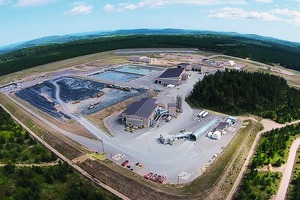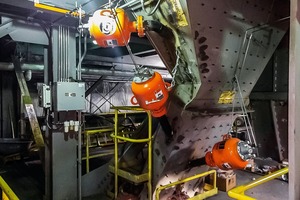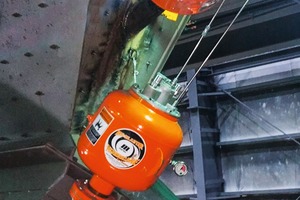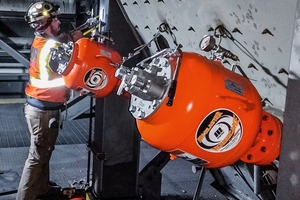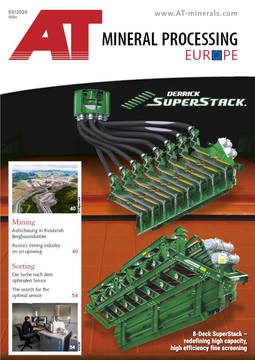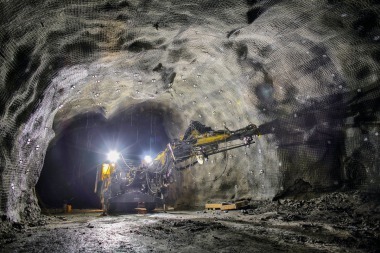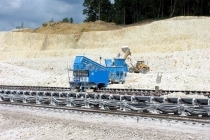Ore mine uses air cannons to unclog chutes
Operators at modern mining sites, such as Eagle Mine located in Western Marquette County of Michigan’s Upper Peninsula, understand that using specialized equipment reduces worker exposure, offers the safest mode of production and provides the most cost-effective lasting results.
Stope mining for nickel and copper
Owned by Lundin Mining, a globally diversified base metals mining company headquartered in Toronto/Canada, Eagle Mine is the only primary nickel mine in the United States, producing 1.5 % of the world’s total nickel production. The first operation permitted under Michigan’s Part 632 Non-Ferrous Mineral Mining Law, it opened in 2014 and is expected to produce 163 300 t of nickel, 134 810 t of copper and small amounts of other metals over its estimated nine-year lifespan.
The company extracts approximately 2000 t/d from the underground nickel-copper mine using a bench-and-fill stoping process. Accessed from the surface by specialized underground trucks, the vehicles carry ≈45.4 t loads through a 1.6 km long and 5.4 m diameter ramp shaft descending into the earth at a 13 % grade. Stoping is a bottom-up method that involves systematically blasting columns of loosened ore that is then mucked by front loaders into trucks and backfilled using cemented and uncemented rockfill.
Ore from the mine is stored in a covered coarse stockpile facility prior to transport by road approximately 105 km to the Humboldt mill. A former iron ore processing plant, the site was converted and refurbished to accommodate Eagle’s updated processing facility. A three-stage crushing circuit reduces the material to 3/8 inch-minus, then a single stage ball mill grinds it further to sand, where it is mixed into a slurry.
To liberate the nickel and other minerals from the waste materials, a refining process of selective flotation is used, mixing the ore with special reagents and agitating it with devices producing air bubbles. As the oxygenated bubbles rise through the heavy slurry at the bottom of the chamber, sulfide particles adhere to the surface and collect as a concentrate containing nickel and copper sulfides at the top of the liquid. The slurry passes through several stages to also release copper concentrates, along with other trace precious metals. The tailings from the plant are safely impounded sub-aqueously in the decommissioned and restored ore pit from the previous plant.
Humidity and ore properties
The clogging issues were found in an undersized chute in the Humbolt milling process. Although material was damp when mucked, it was further exposed to rain, snow or summer humidity during transport by truck to the mill.
During the crushing process, a mesh screen separates the fines from the remaining aggregate, which are fed back through the process. Fines that pass through a screen fall into a wide-mouthed hopper, leading to a chute that narrows to approximately 2.5 m wide by 0.6 m high and – after a dead drop of several feet – slopes abruptly in a ~45º angle of decline. This slope slowed the descent of the fine material for a low impact and centered discharge onto a conveyor belt leading to the ore bins. Material buildup began at the hopper and at the discharge slope, but could also occur at virtually any point, blocking the chute.
Beyond the moisture content, the adherent qualities of the raw material also contributed to the accumulation issue. Some nickel-bearing sulfides can display weak magnetic characteristics at room temperature or higher, which may slightly amplify the adherent nature of the material [1].
Seeking solutions, finding obstacles
Clogging stops the entire crushing process for up to one hour, blocking input of material all the way back to the ore storage area. The breaks in production and ensuing downtime have an immediate effect on the cost of operation.
As soon as the clogging was observed, workers quickly began clearing the obstruction by hitting the side of the chute with mallets and poking at the obstruction with long implements. Eventually, they attacked the clog with 4.5 m long air lances from the top of the hopper and bottom of the chute. The method used a tremendous amount of compressed air and diverted manpower from other essential duties. Moreover, air lances caused excessive splash-back of wet material, which was extremely messy and potentially hazardous.
Recognizing the need for a better solution, Eagle first installed a UHMW polymer lining in the chute. Offering a low coefficient of friction, the lining was bolted to the chute wall and acted like a smooth slide for the material to ride down. Unfortunately, this measure was less effective than hoped for.
To supplement the lining, Eagle next installed pneumatic vibrators onto the vessel wall intended to agitate the adhered material and promote its descent down the chute slope. The impacting action was meant to create a vibratory wave across the vessel surface. Instead, the fact that the polymer lining was bolted to the vessel caused it to muffle the vibration of the units, limiting the force to only the impact zone and not much farther.
Although the solutions reduced clogging slightly, labor was still needed to fully evacuate the material from the chutes.
Compressed air usage
“We realized that the air lance solution was only temporary, but was effective in moving material,” said Jason Haynes, Territory Manager for Martin Engineering. “We proposed installing air cannons at strategic points throughout the chute to dislodge material and aid flow, but managers had some initial reservations.”
Air cannons
Air cannon technology uses compressed air to promote proper flow by quickly filling a tank, delivering a powerful shot to the vessel wall in the direction of the moving cargo, dislodging adhered material and introducing it back into the stream. After Haynes detailed the low impact that new air cannon technology has on compressed air systems, Ted Lakomowski, Lead Reliability Technician at Eagle Mine, advocated for the initial installation of five 35 l Martin® Hurricane Air Cannons, followed by two more placed in essential spots in the chute. All of the tanks were accompanied by a 101 mm pipe assembly ending in fan jet nozzles.
Offering more force output than designs double their size with considerably less air consumption, the compact Hurricane Air Cannon tanks measure only 406 mm in diameter 633 mm long, weighing 35 kg each. The units fire a shot of air at up to 8.27 bar through the fan jet nozzle, where it connects with the pipe assembly and then spreads to 304 mm at the exit point, distributing the airstream across the surface of the wall.
Designed with safety and low maintenance in mind, the cannons feature a centrally located outward-facing valve assembly that can be replaced within minutes, without the need to remove the tank from the vessel. To prevent the risk of unintentional firing due to drops in pressure, the innovative valve design requires a positive signal from the solenoid in the form of an air pulse to trigger release.
Installation and testing
For access inside the chute, installers first removed the lining and cut holes to fit the air cannon pipe assemblies, which pointed at a 30º angle in the direction of the cargo stream. Beginning with 5 cannons, one unit was placed at the area where material discharged into the hopper, two others were positioned at the hopper slope where the most accumulation was observed and two more were placed along the drop chute. These used straight pipe nozzles to shoot air across the vessel to dislodge adhered material and promote flow.
“The initial installation reduced the amount of downtime, but testing showed it did not cover enough area to fully evacuate adhered material,” said Jason Haynes. “More accumulation built up in transition sections of the hopper and discharge slope than initially thought. So we installed one more cannon at the top of the hopper and one at the bottom of the chute where it discharged. We also added the fan jet nozzles to the pipe assemblies to cover more area, and that did the trick.”
A single solenoid box was installed to control up to ten cannons and was safely located away from the firing area. Connected to a distributed control system (DCS) in a central control room, operators can monitor and adjust firing sequences from a remote location or fire the cannons directly from the solenoid box without needing to interact with the cannons.
Results
Operating on a regular firing schedule of every 1 to 10 min – readjusted for production volume, time of year and moisture level – revealed the seven cannon configuration reduced clogging issues and downtime. Lakomowski said: “It’s a significantly lower effect on our system than initially predicted, and managers are very happy about that. Overall, this was a successful project.”
Autor/Author:Mike Moody, Business Development Manager, Martin Engineering
Literatur • Literature
[1] Taylor, John; Wise, Edmund: “Nickel processing – Extracting and Refining – From Sulfide Ores”; Encyclopedia Britannica. Sept. 5th, 2003. //www.britannica.com/technology/nickel-processing" target="_blank" >www.britannica.com/technology/nickel-processing:https://www.britannica.com/technology/nickel-processing

